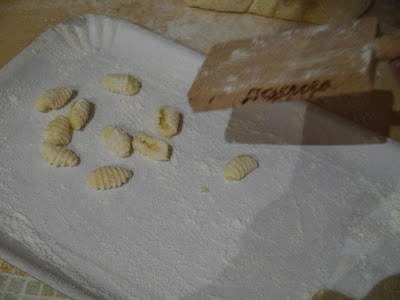 |
| Cristina and the Stregna |
Gnocchi
Boil about 1 kg of potatoes, then peel them. Shred the potatoes to an airy mash with a potato shredder (called a 'ricer').
Add one egg to the potatoes, and knead with roughly 400 g of plain flour.
Knead until the flour is blended, adding it little by little - but not too much! Too much flour will make the gnocchi tough and stodgy, not light.
When blended to a dough, roll out on an floured board to form a long tube about 1 cm in diameter (as thick as your finger). Chop this into pieces about 1 cm long. The roll each gnocchi on a 'gnocchi board' with your thumb. The potato dough should be springy and each gnocchi will form into a shell with one grooved side formed by the gnocchi board.
Bring a large pan of salted water to the boil. Toss in the gnocchi, about half at a time. They will cook quickly, within a few minutes. When they rise to the top of the pan they're done. Scoop out with a draining spoon, draining off all the water. Add to a large bowl with tomato sauce; toss in the sauce. Serve immediately with grated parmesan cheese.
 |
| The potato shredder ('ricer') |
 |
| Umberto at work. |
 |
| Adding one egg and flour to the shredded potato. |
 |
| Knead carefully and lightly. Not too much flour. |
 |
| Rolling the gnocchi. |
 |
| Use your thumb. |
 |
| perfeto! |
 |
| Ready to boil. |
 |
| They're done when they rise to the top. |
 |
| The gnocchi is done. Draining. |
 |
| buon apetito! |
Tomato Sauce for Gnocchi
Finely chop a red onion into a hot pan, cook a little until softened. Add a little olive oil, then a jar of home-preserved tomato sauce (or sauce made from fresh tomatoes). Stir together, bring to the boil, then simmer for one hour. Add a little basil at the end.
 |
| First, grow your cherry tomatoes.... |
 |
| Leave to simmer for one hour. |
Make a large sponge cake. Here's an authentic Italian recipe.
Slice the cooled cake in half. Soak each half with lemon sugar syrup, made by boiling sugar, water and lemon juice; and sprinkle with a liqueur such as 'Stregna' (saffron), or vermouth, bourbon, limoncello, etc.
Then spread the lower half with lemon cream; dot with preserved sour cherries ('Amareisa' brand). Top with the other half, then soak the surface of the cake with the lemon syrup and the liqueur.
Ice the cake with egg-white icing. Place in refrigerator until ready to serve.
 |
| First, make your sponge cake. |
 |
| Slice the cake in half. |
 |
| Lemon sugar syrup, with the rind of Amalfi lemons. |
 |
| Adding the sour cherries. |
 |
| Spreading the egg-white icing. |
 |
| Done! |
 |
| bellisimo! |
2 whole eggs
1 egg yolk (reserve the white for the icing)
150 g sugar
80 g flour
0.5 l milk
slices of rind from one lemon.
Combine the eggs, sugar and flour with a little milk and beat until blended (by hand or with a mixer). When well blended, add all the rest of the milk at once and stir together.
Stir on heat with love and passion, for about 10 minutes, until the cream thickens and bubbles begin to rise. Remove from heat and sit the pot in cold water. Remove the lemon rind to avoid a sour taste. Now prepare your pan di spagna as above and soon the cream will be ready to spread in the centre of the cake.
 |
| Beat well. |
 |
| Add the rind of an Amalfi lemon. |
 |
| Stir with love and passion. |
1 egg white
about 1 cup of lemon juice (the juice of one Amalfi lemon)
150 g (3 large tabs) icing sugar
Beat these ingredients together well with a mixer. Then cook the mixture gently over hot water (in a bain marie or double boiler). It's done when it attaches to the pan.
Spread on the top of the pan di spagna - it will be runny and run down the sides of the cake.
Optional: decorate the top of the cake.
Refrigerate.
 |
| Add icing sugar to egg white and lemon juice. |
 |
| Stir gently in a bain marie. |
The equipment:
.jpeg) |
| Potato ricer (source) |
 |
| Gnocchi board (source) |
No comments:
Post a Comment